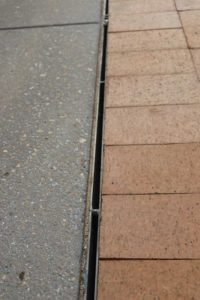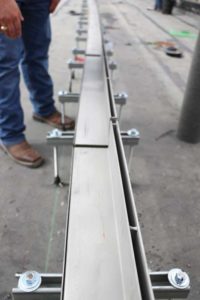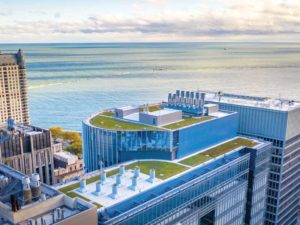Extruded polystyrene in protected membrane roof assemblies
As a rule, higher density correlates with higher strength in XPS insulation board. ASTM C578 Types VII and V are suitable for applications that may have high point loads (e.g. applications with raised pavers or PV arrays). Type V is capable of withstanding high loads such as what may be experienced with vehicle parking on the building’s rooftop.
 ASTM C578 XPS types IV, VI, VII, or V each would be suitable for a typical ballasted PMRA. More ballast or ballast securement may be required for high wind zones and, as a result, higher compressive strength. The International Building Code (IBC) requires ballast designs be in accordance with ASNI/SPRI RP-4.
ASTM C578 XPS types IV, VI, VII, or V each would be suitable for a typical ballasted PMRA. More ballast or ballast securement may be required for high wind zones and, as a result, higher compressive strength. The International Building Code (IBC) requires ballast designs be in accordance with ASNI/SPRI RP-4.
CAN/ULC S701.1 classifies polystyrene insulation into types differently than ASTM C578. XPS for PMRAs per CAN/ULC S701.1 would typically be Type 4. CAN/ULC S701.1 requires the same ASTM test procedures for determining the density and compressive strength of XPS (ASTM C303 and ASTM D1621, respectively).
A roof assembly’s fire classification is a very important factor. The discussion of roof assembly fire classification is beyond the scope of this article. Specifiers are referred to ASTM E108,12 UL790,13 or CAN/ULC-S10716 for more about fire classification.
The overall thermal resistance of the PMRA is improved with effective drainage. Ponded water between the insulation and the membrane for long time periods could contribute to moisture absorption, which even for XPS would require R-value adjustments. For this reason and others, drainage systems are essential in most designs of PMRAs even when using XPS insulation. A PMRA typically allows for drainage between the roof covering and the XPS insulation board. A drainage gap can be accomplished with a perforated or dimpled mat made of polyethylene, rubber, or a composite material; or the XPS itself could contain channels, slots, or kerfs to aid in drainage.
There are many considerations in the design of PMRA: structural performance, wind uplift resistance, means of egress for occupiable roofs, and other factors. Fortunately, much knowledge and experience has accumulated in recent years and more and more contractors and building materials suppliers are knowledgeable of standards and best practices.

Published guidance has been developed about PMRA and is still evolving. The interested architect or designer is encouraged to contact one or more of the XPS manufacturers for recommendations on designing a PMRA that will provide maximum durability and performance.
Thermal resistance and structural integrity
Specifiers of the components of PMRAs must balance form and function with a high degree of knowledge of PMRA components.
∞ Below the insulation, the roof covering installed to the deck and a suitable drainage system regulates the water retention;
∞ The insulation itself is thick enough to provide the desired amount of thermal resistance; and
∞ Above the insulation, the ballast holds down the XPS, which must be strong enough to withstand the weight of the ballast as well as variable loads such as rainfall and human or vehicular traffic.
XPS floats on water. If there are several inches of water on the roof because of a sudden downpour, then hydrostatics requires the weight of the volume of displaced water be countered with at least the same weight in ballast. Hydrostatics tells how much ballast is necessary to keep the XPS from floating.
Ballast is used to provide uplift resistance for roof assemblies that are not adhered or mechanically attached to the roof deck. However, buoyancy is not the only factor in determining the ballast requirement. The PMRA must meet standards relating to wind uplift resistance. The height of the parapet wall surrounding the PMRA has a striking effect on wind uplift. For a detailed discussion of ballast design requirements, refer to ANSI/SPRI RP-4.
PMRA application examples
The following examples demonstrate XPS insulation solutions for various projects where performance requirements for thermal resistance and structural integrity are solved with XPS insulation. These application examples focus on the insulation layer for PMRAs.
The application examples provide general guidance for specifying various types of PMRAs. However, the details may vary from project to project and for different roof sections on the same building. It is recommended specifiers work closely with the suppliers of the XPS insulation as well as other component suppliers.

Example 1: PMRA with solar-reflective aggregate
The first application example is for a ballasted PMRA assembly on top of a concrete deck with a high solar reflectivity top layer of aggregate ballast. This PMRA is for a building which is located in a mixed humid climate (ASHRAE 90.1 Zone 4). The roof area of this building is 19,264 m2 (207,360 sf).
An R-value of 5.28 K·m2/W, or R-30 (30 F·sf·h/Btu) was obtained using 152 mm (6 in.) of ASTM C578 Type VI XPS. The compressive strength of 276 kPa (40 psi) was adequate for the relatively light load on this PMRA thanks to adequate drainage. The bottom layer of the XPS insulation board itself contained drainage channels facilitating water removal through a drainage system.
A fabric material on top of the 152 mm of XPS separates the XPS from the aggregate and helps to prevent displacement of the insulation. The only thing holding down the XPS insulation is the aggregate ballast. Hence, installation occurs in stages with the insulation being covered with fabric and aggregate soon after it is laid down on the waterproof roof covering.
The insulation and the reflective ballast greatly reduce the heat load on this building. This is an environmentally friendly solution because the PMRA not only extends the service life of the underlying membrane by protecting it from UV radiation and high temperatures, but also saves on cooling energy costs for this building which is in a mixed humid climate.







